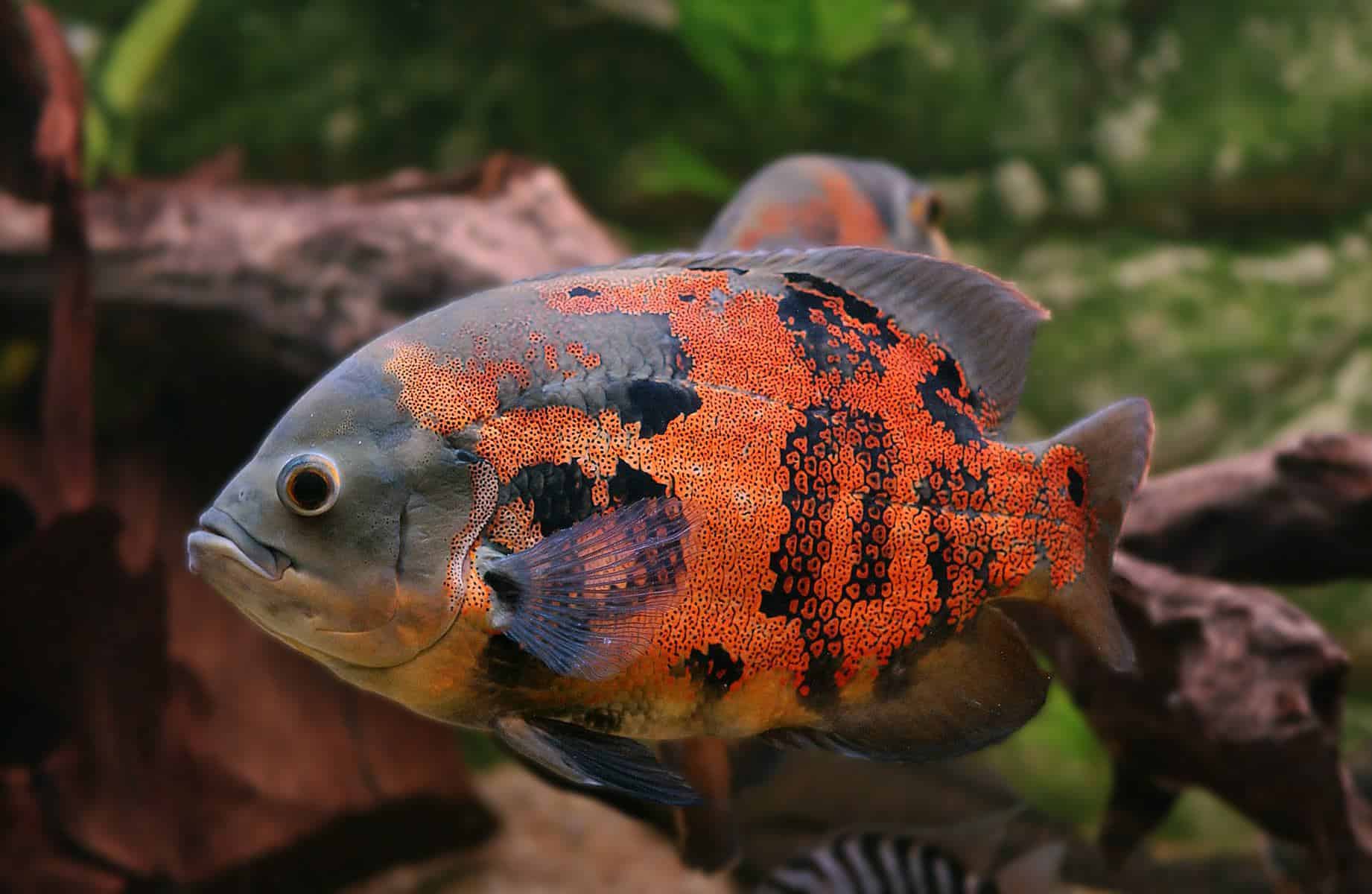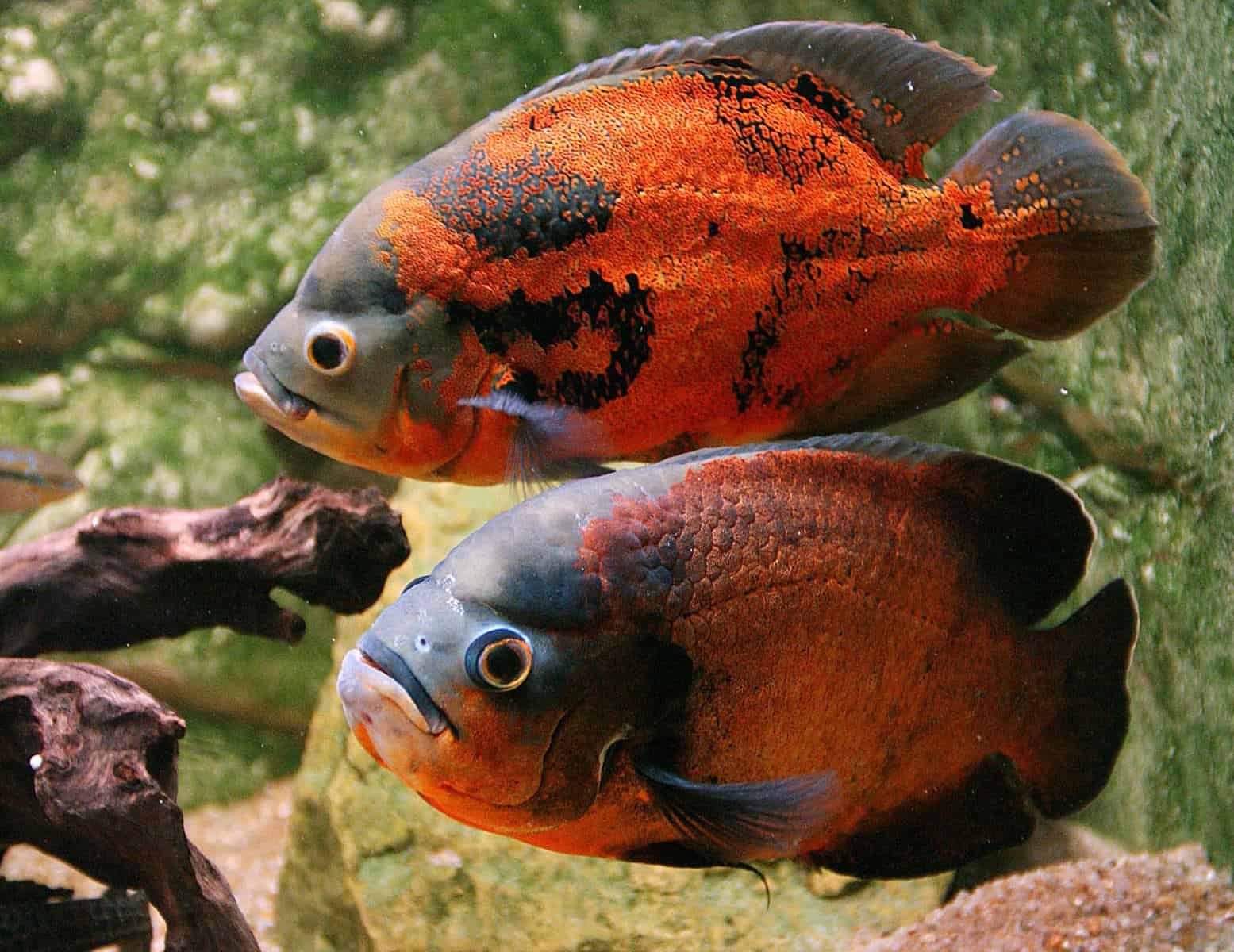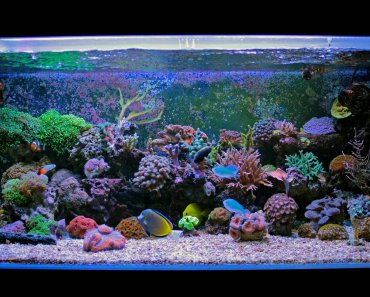Oscar fish are notorious for being aggressive and difficult to keep. But is that the truth or just an urban myth?
Oscar fish are more suitable for experienced fishkeepers, partly because of their temperament but also because of their size. However, once you have oscars in your life, you’ll be captivated by their intelligence, dazzling good looks, and fascinating social behavior; all the work of caring for these finned creatures in your tank set-up will be well worth it once you realize the oscar is your new favorite fish.
Read this guide to learn everything you need to know about the spectacular oscar fish, from the basics of keeping it alive and well to how to breed them.
Oscars, whose scientific name is Astronotus ocellatus, are members of the Cichlidae family of fishes. Oscars come from South America, specifically along the Amazon River in Peru, Brazil, French Guiana, and Ecuador.
There are also a few outlying populations of oscars in China and North America, although it’s thought the fish here are descendants of previously captive specimens that were released by their owners when the fish got too big for their tanks.
Oscar fish behavior
Oscars are active swimmers, spending much of their time cruising the middle of the water and making occasional forays to the bottoms of their environments to scavenge for scraps of food.
That behavior can be a problem in aquariums with lots of tank decor, as the fish tend to uproot plants and overturn other trinkets, so you’ll need to make sure everything is securely anchored.
Are oscars aggressive fish?
Oscars are highly territorial, and they will attack fish that encroach on their patch. These fish can also become aggressive at feeding times and during spawning.
What do oscar fish look like?

Oscars have long, oval-shaped bodies. Their anal and dorsal fins extend along the length of the fish’s body to the caudal fin, or tail, forming a most attractive fan shape. These fish are commonly known as tiger oscars, thanks to the pattern of random black and orange patches over the body. However, that coloration may change as the fish matures.
Male and female oscars are very similar in appearance, but if you look very closely at the genital area, you can sometimes tell the difference between the two sexes.
Other oscar varieties
In addition to the original tiger oscar’s coloration, many different varieties have been produced over the years via selective breeding experiments, which means oscars as a whole are quite colorful fish.
Red oscars, for example, are red with black or white fins, yellow oscars are solid yellow with black or white fins, and albino oscars are boldly colored white with white fins.
How big do oscar fish get?
These fish grow very quickly, gaining as much as one inch per month until they’re fully grown. All varieties of oscars can reach 12 inches in length when fully grown.
How long do oscar fish live?
Oscars generally live for up to 20 years in the wild and on average for over 12 years in captivity, so adding them to your setup is certainly a long-term commitment!
How can I create the ideal oscar tank?
As with any fish species, the ideal tank setup will replicate the fish’s natural habitat as closely as possible.
In the case of the oscar fish, the natural environment they inhabit is warm and the water pH is close to neutral, which means these fish don’t tolerate extremes of alkalinity or acidity.
The current in these river habitats is strong and the visibility in the water is quite cloudy. The river bottom here is mostly soft, sandy material littered with rocks, sunken branches, and debris and with floating aquatic plants above.
How to care for oscar fish
Now that you know a little more about oscars and you have your heart set on keeping these popular freshwater fish, you’ll need to know to care for these gorgeous creatures.
Tank size
Since oscars can reach up to a foot in length, you’ll need a big tank to house them. We recommend at least a 55-gallon tank for one fish. However, if you intend to keep more than one specimen, you’ll need an aquarium of at least 100 gallons. As a general rule of thumb, you need to add 20 to 30 gallons’ capacity for every additional fish.
Choose a long tank that has plenty of swimming space for the fish. And because oscars are powerful fish that may jump if startled, any tank you consider storing them in should have a tightly-fitting lid.
Tank setup
To replicate the oscars’ natural home, use a layer of soft, sandy substrate to line the bottom of the tank. Don’t use a coarse gravel substrate, as that could injure your fish when they begin digging.
Decorations like driftwood, bogwood, twisted roots, and rocks look good in oscar tanks, and a few caves are recommended so that each fish has somewhere to claim as its territory. Just remember to secure all your decorations firmly in place so that the oscars’ digging habit doesn’t dislodge everything.
Oscars don’t need any specific form of lighting, so standard LED aquarium lights are fine.
What about plants?
Live plants are an excellent addition to any freshwater tank. They help to keep the water clean and safe for your fish by absorbing nitrates and CO2 and producing oxygen through photosynthesis.
Your oscars won’t eat the plants, but they do tend to dig around the plant bases in search of food, which can uproot the plants. We recommend you use plant weights to secure the plants until the root systems become well established, or put your plants in clay pots.
Floating plants are an excellent choice, and robust species like hornwort should also survive any disruption that the fish cause.
Water conditions
Oscars are large fish that produce a fair amount of waste, so you’ll need a powerful external filtration system with a decent GPH (Gallons Per Hour) flow rate. If necessary, use additional powerheads to increase the current.
Oscars are tropical fish that need a water temperature of between 74 and 81 degrees Fahrenheit. The water’s pH needs to be in the range of 6.0 to 8.0 with a water hardness of 5 to 20 KH.
What are good tank mates for oscar fish?
Ideally, Oscars should be kept in a single-species tank. However, some large, docile fish species can work well in a community setup that includes oscars. A few examples of suitable tank mates include:
Generally, other large cichlids make good tank mates for oscars, as they are usually able to defend themselves or keep out of the way when necessary.
Basically, any fish that’s small enough to be eaten is not suitable for life in a tank with oscars. It’s the same story for shrimp, snails, and other small invertebrates, too.
Can you keep a group of oscars together?
The safest option is to keep a group of oscars together, provided you don’t overcrowd the tank. As long as each fish has plenty of space to claim a territory, the oscars should live in relative harmony.
What do oscar fish eat?
Feeding oscars is pretty straightforward, as these omnivorous fish will eat virtually everything they’re offered!
In nature, oscars eat plant matter, small fish, insects, and their larvae, and crustaceans. In a captive environment, you can feed your fish flakes and pellets, including formulated specifically for cichlids. You can also feed your fish frozen foods, including daphnia, brine shrimp, and bloodworms. Oscars also appreciate the inclusion of some chopped-up green veggies such as zucchini, spinach, and lettuce.
Live foods are a good option as they encourage the fish to hunt for their food, as they would in the wild environment. However, be careful that you use a reputable supplier for your live foods and don’t harvest anything from nature yourself, as live food often harbors parasites that could get into your tank and harm your fish.
How often should I feed my oscars?
We recommend you feed your fish twice or three times a day, offering only what the fish will clear up in a couple of minutes. Observe the fish at feeding times, as oscars can become very aggressive when there’s food on offer.
Can you breed oscars at home?

Unfortunately, oscars are one of the hardest fish to breed in home tanks. They are very fussy when it comes to choosing a mate, and they prefer to pick their own partners rather than having you decide that for them!
One option is to buy an established mated pair. Alternatively, you could buy a small group of juvenile oscars so they will naturally pair-off as they mature. Oscars are not sexually mature until they reach one or two years of age, so if you decide to take that route, you might have a long wait before any babies are produced.
Spawning behavior
In the wild, oscars spawn during the rainy season. To replicate that in the home tank, you need to lower the temperature by a few degrees. Carry out water changes every other day and sprinkle water on the surface a few times each day to simulate a downpour.
Before spawning, the male fish flare their gills and display them to their mate. The couple cleans a flat rock surface ready to receive the eggs. Large females can lay as many as 3,000 opaque white eggs in one spawning.
Both parent fish keep watch over the eggs until hatching takes place, typically within two to three days. During that time, the females fan the eggs to keep them clear of a covering of substrate, while the male chases other fish away from the nest.
Once the fry has hatched, you need to move them to a separate tank with a sponge filter. Feed the youngsters up to four times every day to boost their growth, and be ready to move the juvenile oscars to a larger tank as they grow to prevent stunted growth.
Are oscars hardy fish?
Oscars are generally healthy, hardy fish as long as you provide them with nutritious, varied diets and keep their tanks clean and correctly maintained. However, there are a few common fish diseases that can affect oscars.
Hole-in-the-Head (HITH) Disease (Oscar Disease)
The cause of HITH disease is not fully understood. However, it’s thought that the parasite Hexamita could be to blame. There are a few other factors that can contribute to the disease, including overcrowding, mineral or vitamin deficiencies, poor diet, or substandard water quality.
Symptoms of HITH include pitting and lesions on the fish’s head and lateral line, white sores on top of the fish’s head and around its eyes, large holes and sores on the body that weep mucus, and poor appetite.
HITH disease is usually fatal if it isn’t treated correctly and promptly. If you can persuade your fish to eat medicated fish food, try treating it with metronidazole. Or, you can bathe your fish in it for six to 12 hours.
Treating the disease isn’t enough; you’ll also need to correct the incorrect husbandry that might have caused the problem in the first place.
Ich
Ich is also called white spot disease and is a very common ailment of pretty much all aquarium fish species.
Ich is caused by the protozoan parasite, Ichthyophthirius multifiliis. The parasite usually gets into your tank on plants, new fish, or in live food. Signs of ich include poor appetite, red patches on the fins, rapid respirations, flicking or rubbing the body against the substrate or other tank decor, and white spots on the body, gill covers, and fins.
You can treat ich by increasing the water temperature to 82 degrees Fahrenheit for three days while treating the water with an over-the-counter white spot remedy from your local fish store.
Columnaris (Fin Rot)
Fin rot is primarily caused by a bacterial infection. However, stress, overcrowding, poor water quality, and low oxygen levels can all be contributing factors. Sometimes, the infection can take hold in tissue that’s damaged by knocks and abrasions.
Symptoms of columnaris include ripped and bloody fins, loss of part of the tail or fin, lethargy, poor appetite, hanging at the water surface, and slime or cloudy appearance of the body or fins.
Fin rot can be treated with antibiotic medication from your local fish store. It can also help to carry out a 30 percent water change before treatment, and you can add aquarium salt to the tank as per the manufacturer’s directions.
Popeye Disease
Popeye disease is typically caused by keeping your fish in tanks with chronically poor water conditions. The symptoms of popeye include bulging, swelling, or cloudiness in one or both eyes.
The disease affects the cornea and causes fluid to accumulate behind the eyeball, and there’s often a secondary bacterial infection, too.
To treat popeye, correct the water conditions and treat the water with over-the-counter antibiotic medication.
Dropsy or Bloat
Dropsy or bloat is a very serious condition that can be caused by a number of things rather than having one single trigger.
Probably the most common cause of dropsy is constipation caused by overfeeding. Symptoms of constipation include a swollen abdomen and bloated appearance, erratic swimming (inability to keep on an even keel), and lack of feces (or hard feces) trailing behind the fish. You can often relieve constipation by withholding food for 48 hours and then feeding live or frozen meaty foods.
A fish with dropsy will have a very swollen belly, and the scales appear pinecone-like. The fish will most likely stop eating and have problems swimming. Although constipation is usually curable as described above, dropsy is far more serious and often results in the death of the fish.
Availability
Oscars are usually available in most fish stores and online. Price varies depending on the color and size of the fish, typically starting at just a few dollars per fish for a regular tiger oscar whose size is around three or four inches long.
Are oscars suitable for my tank?
Oscars are best kept by experienced aquarists who have a large tank. It’s advisable to begin with one oscar as a feature fish and build the rest of your tank set-up around that.
Oscars are easy to feed and care for, provided that you keep the aquarium well-maintained and manage the water quality properly. That said, oscar fish can be aggressive and territorial, so choosing tank mates can be challenging.
Although it’s tricky to breed oscars in the home tank, it’s not impossible, and keeping these interesting, beautiful fish is very rewarding.

























